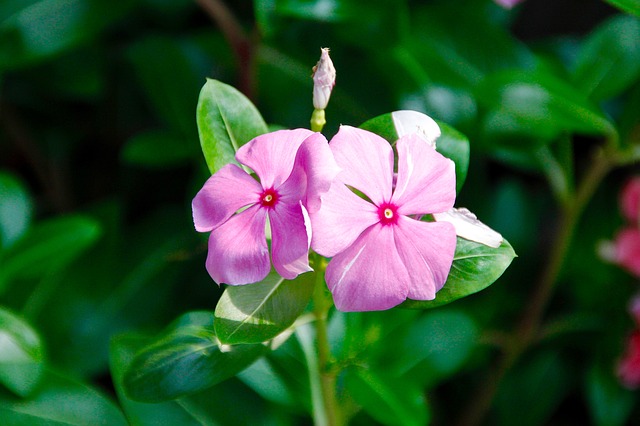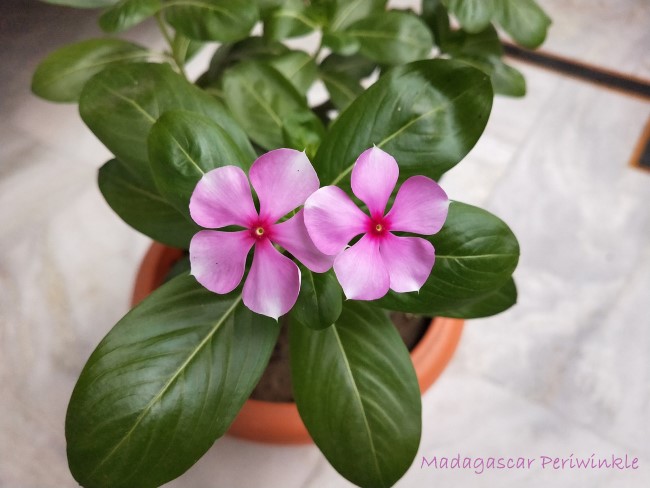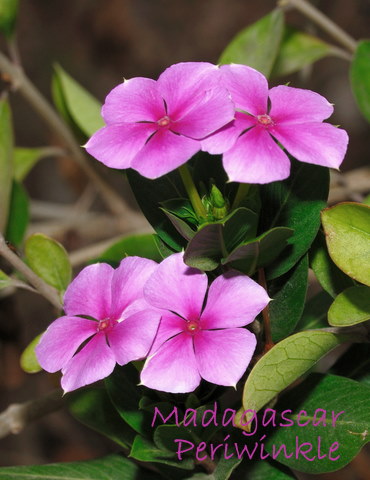Madagascar Periwinkle Flower
Botanical Name: Catharanthus roseus
Plenty of sunshine will make periwinkle flower from summer through fall.
This Madagascar native is related to the Vinca species, known for its true-blue flowers. There is a resemblance, but this tropical relative has a beauty all its own.
 Give your periwinkle plant lots of light to give it more blooming power.
Give your periwinkle plant lots of light to give it more blooming power.Get to Know this Tropical Periwinkle Flower
A charming indoor houseplant, this shrubby plant has upright stems densely covered with shiny, dark-green oval leaves, which feature prominent light-green midribs.
Star-shaped periwinkle flowers are small -- only 1 in (2.5 cm) across -- but they cover the plant in abundance if given enough sunlight. And you don't even need to bother deadheading; this easy-care plant is eager to bloom without help.
Flower buds open to five, flat lobes, that are typically rose-pink with a deep-pink throat. You may also find them in white or pale lavender.
Newer cultivars may sport bigger flowers with more vibrant colors.
You can buy Madagascar periwinkle plant from a nursery or garden center in the spring and summer. Choose one with plenty of flower buds -- a sure sign of a healthy flowering plant.
How to Care for Madagascar Periwinkle
Let the sun shine in. Flowering plants need plenty of light to bloom. To help your Madagascar Periwinkle flower, keep your plant where it'll get a few hours of sunlight every day.
Or move it outside. Growing periwinkle plant in a sunny spot outdoors for the summer will give it more blooming power. Don't worry -- it can take the heat. Just be sure to bring it back inside before the temperature drops to 60°F/16°C at night. It doesn't like the cold at all.
Give it some space. Madagascar periwinkle is a vigorous grower, quickly filling a small pot in a short time. Repot when your periwinkle plant outgrows its pot, moving it up to a pot 1-inch (2.5 cm) larger. Don't over-pot, because a too-large container will hold too much water, which can lead to root rot. Besides, it blooms best when its roots are a little snug.
Wondering whether to overwinter? This tropical plant is a tender perennial and can be kept over the winter; however, it likely won't bloom much the second year. Don't feel guilty about tossing it out after the flowering season is over in fall. If you want to keep it, water sparingly and stop fertilizing till you see new growth in spring. Then resume normal care.
Is Madagascar Periwinkle poisonous? Yes, all parts of the plant are toxic to people, cats and dogs if eaten. The good news -- it seems to shrug off pests. And if you move Catharanthus roseus outdoors for the summer, deer won't touch it.
 Madagascar periwinkle flowers are small, but this tropical houseplant is a prolific bloomer.
Madagascar periwinkle flowers are small, but this tropical houseplant is a prolific bloomer.Madagascar Periwinkle Flower Care Tips
Origin: Madagascar
Height: 12 in (30 cm)
Light: Madagascar Periwinkle thrives in full sun, as long as it is well-watered. Plants that don't get enough light will grow tall and leggy, with few blooms. Moving it outdoors for the summer may be just the solution.
Water: Water thoroughly and often to keep soil evenly moist. Use a pot with drainage holes to prevent soggy soil. Larger plants are drought-tolerant.
Humidity: This tropical native likes moist air. If relative humidity falls below 50%, mist the foliage and place the pot on a tray of wet pebbles.
Temperature: Average to warm 65-85°F/18-29°C. If you move Madagascar Periwinkle outside for the warm months, don't worry -- it can take the heat. However, it will only tolerate a minimum of 60°F/16°C, so bring it back indoors when the temp drops in autumn.
Soil: Use a fast-draining potting mix. You can use an all-purpose mix and add a little perlite.
Fertilizer: Feed every 2 weeks with a balanced water-soluble fertilizer diluted by half while periwinkle plant is growing and flowering.
Propagation: Sow seed indoors in late winter or early spring. Maintain 70°F/21°C for germination, which takes about 2-3 weeks. New 3 in (8 cm) stem tip cuttings can be taken in spring or early summer and planted in moist potting mix.
 You can expect an abundance of flowers in summer.
You can expect an abundance of flowers in summer.

